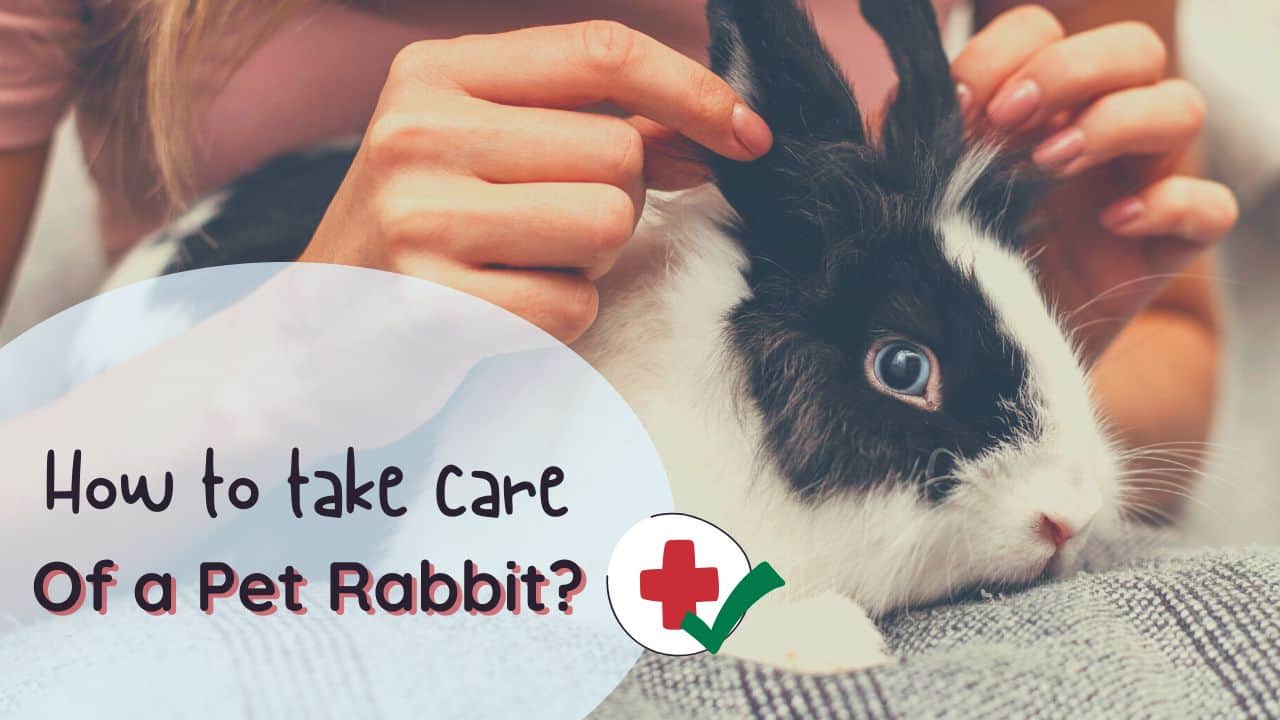Are you thinking about bringing a pet rabbit into your household and wondering how to take care of a bunny?
I’m thrilled to hear that! Rabbits are spunky, cuddly companions and will brighten your daily routine with their antics.
But I’m not just pleased to hear that you’re considering adopting a rabbit. I’m extra excited that you’re taking the time to research how to care for your bunny the right way.
Rabbits are among the most popular small pets – but also one of the most misunderstood. When I got my first bunny, Biscuit, in 2001, I read every book at the library on pet rabbit care. I found lots of conflicting information in those books. I even found rabbit healthcare advice that is downright dangerous.
Since then, I’ve spent 20+ years rescuing and caring for rabbits. In this essential rabbit care guide, I’ll share my top tips for helping your rabbit enjoy a long and happy life.
This guide will cover:
- The Best Habitat for a Pet Rabbit
- A Healthy Diet for Bunnies
- Common Health Issues and How to Avoid Them
- Rabbit Grooming and Hygiene
- A Rabbit’s Emotional Needs
- How to Handle and Play with your Bunny
How to Take Care of a Bunny
Pet rabbits need these basics to stay happy and healthy:
- A large habitat where they can exercise.
- A safe, peaceful, and clean environment.
- Unlimited timothy hay to eat with vegetables, pellets, and water.
- A relationship with a reliable veterinarian.
- The chance to bond with humans and/or other bunnies.
The Best Housing and Environment for a Pet Rabbit
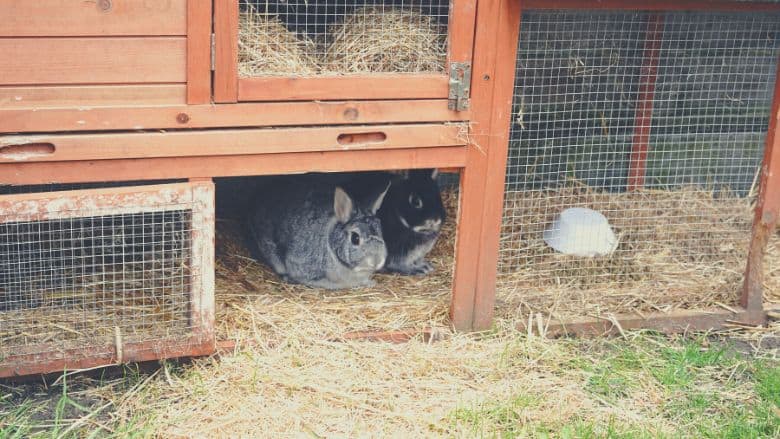
Rabbits can thrive indoors or outdoors, as long as their space is quiet, clean, well-ventilated, secure from both attacks and escape, protected from extreme weather, and provides plenty of room to exercise.
Are Cages Good or Bad for Rabbits?
Many new pet owners assume that rabbits need to live in cages, and others wonder if cages are inhumane. Neither of these extremes is necessarily true.
Cages are bad for rabbits if they are too small and don’t allow bunnies room to exercise.
A cage for a medium-sized rabbit should have at least 8 square feet of floor space.
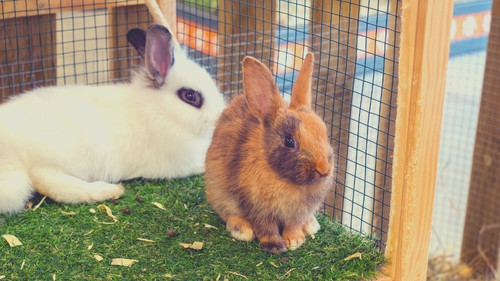
But cages are good because they provide security for rabbits. When bunnies know that they have their own space to which they can retreat if they feel frightened, it gives them the confidence to come out of the cage and explore their surroundings.
When we brought my son’s rabbit, Rexy, home for the first time, she wanted to play, run, and sniff around our living room. But she insisted that we keep her cage door open. She wanted the option to go in or stay out if she pleased.
Habitat Needs of Indoor Rabbits
Start by choosing a quiet room in your home to be the rabbit’s primary habitat. You should be able to close the door to this room so your rabbit can have some space away from children or other pets when needed.
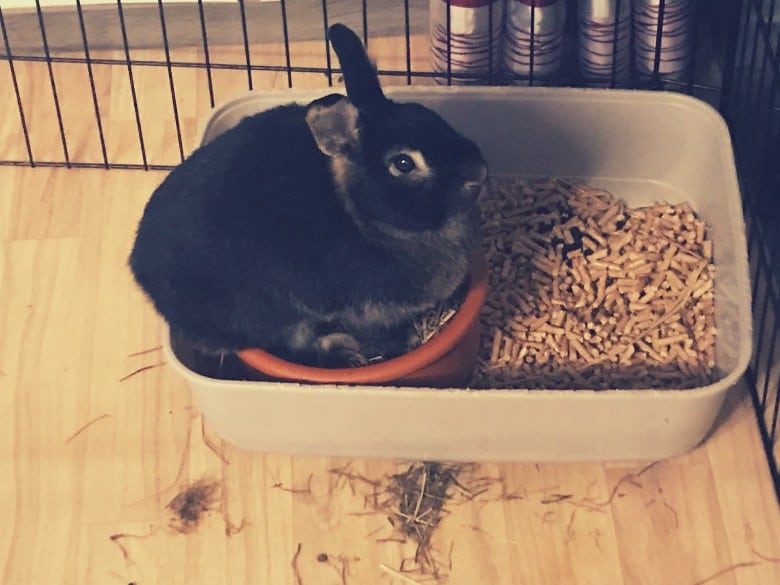
Next, “bunny-proof” the space by covering outlets, moving electrical cords out of reach, and protecting furniture legs with chew-proof wrap.
Then set up an enclosure within the room to be your rabbit’s personal domain. This can be a cage on ground level or an exercise pen placed on a nonslip surface.
Your rabbit needs a cage or pen because, even if you give Bunny free range of the room when you’re home, he needs a secure place to hang out while you’re asleep or gone for the day.
Place an igloo or wooden box within the cage or pen to be the rabbit’s nesting space. Rabbits love hiding in their “burrow box” when they feel insecure or just want to get cozy.
You’ll also need a solution for the rabbit’s bathroom needs. You can place a litter box in the cage or pen, but remember that it may take some time for your rabbit to learn to use it.
Habitat Needs of Outdoor Rabbits
Rabbits living outside will definitely need a cage or a hutch to protect them from predators and the elements.
A safe outdoor rabbit home must include the following features:
- Protection from weather extremes. At the minimum, an outdoor rabbit cage must keep rabbits dry, out of the wind, and out of direct sunlight.
- Made of secure materials. Rabbits are incredible gnawers and can chew through a wood 2×4 board. An outdoor cage should either have a solid wood floor or be made entirely of 14 or 16-gauge wire. Absolutely no chicken wire.
- Elevated above ground level. Keeping your outdoor rabbit cage on 3-foot legs will help protect your bunny from dogs, coyotes, and raccoons.
If you have an outdoor rabbit that lives in a cage, it’s still important to take your bunny out for regular exercise. You can let your rabbit play in a large outdoor run or rabbit tractor.
How to Feed Pet Rabbits
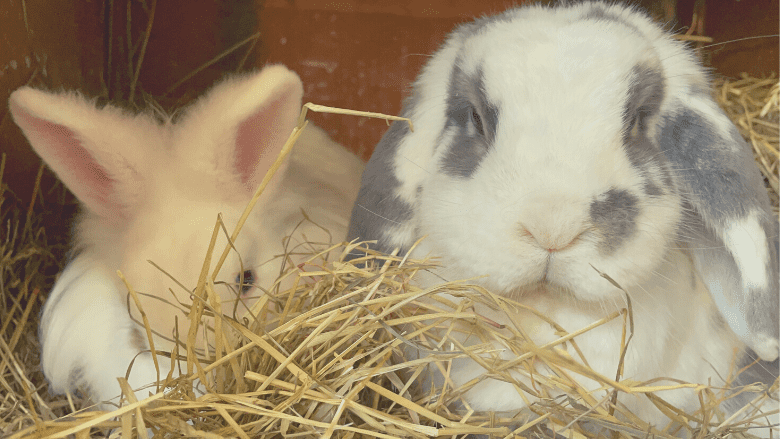
Most veterinarians recommend feeding your rabbit a diet consisting mostly of timothy hay. Hay is simply dried grass, made from timothy, oat, or alfalfa plants.
Hay – The Essential Rabbit Food
Fiber is the most critical macronutrient for rabbits, and hay is very high in fiber. A healthy diet for rabbits will be at least 22-27% fiber.
Fiber keeps the rabbit’s digestive tract running consistently and promotes the growth of beneficial gut bacteria. These bacteria help the rabbit break down and extract nutrients from its food.
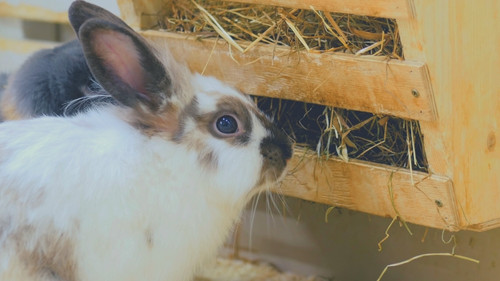
In the wild, rabbits graze most of the day and are constantly digesting a small amount of high-fiber greenery, keeping their GI tract running like clockwork. We can replicate this by feeding our pet rabbits timothy hay “free-choice,” which means having it available whenever they want it.
A healthy diet for a pet bunny is 80% hay, 15% leafy vegetables, and 5% commercial pellets. Fruit and starchy vegetables should be restricted to special-occasion treats.
Is Timothy or Alfalfa Hay Better for Rabbits?
Timothy is a perennial grass and alfalfa is a legume. This means that timothy hay is higher in fiber and alfalfa is higher in energy and protein. Depending on their stage of life, different rabbits will need different nutrient ratios.
Many vets advise against feeding alfalfa because its high calcium content can contribute to urinary tract issues in rabbits.
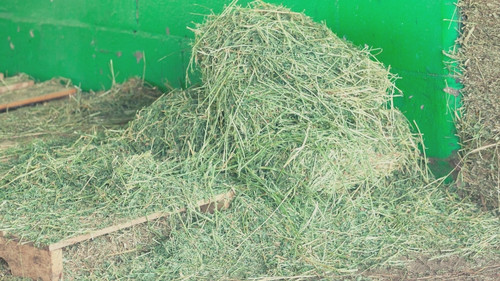
Other experts disagree, arguing that the richer nutrients in alfalfa can be beneficial as part of a balanced diet.
Since companion rabbits aren’t breeding or lactating and don’t need extra calcium or protein, my experience is that it’s best to stick with Timothy hay for your pet.
Can I just give my rabbit grass from the yard?
Grass from the lawn should not replace hay in a rabbit’s diet. Yard grass is usually safe for rabbits to have in small quantities as long as it’s definitely not been treated with chemicals.
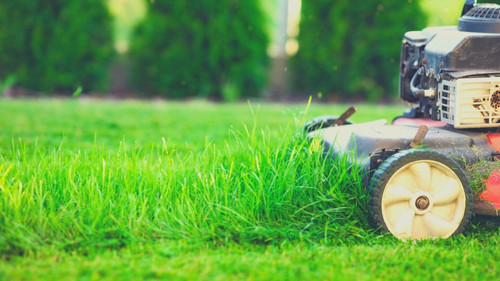
Lawn grass has a much higher water content than hay and different macronutrients. It will take your rabbit’s stomach time to adjust to it, so don’t give too much at once.
Should rabbits eat vegetables?
Good vegetables for rabbits to have regularly include broccoli leaves, romaine lettuce, bok choy, carrot tops, beet greens, and cilantro. These are rich in vitamins and add interest to your rabbit’s diet.
Other vegetables that are okay in limited quantities include kale, swiss chard, spinach, summer squash, and brussels sprouts.
Are pellets good for rabbits?
Commercial rabbit pellets have their pros and cons. It all depends on the quality of the formula and the way you use them in your rabbit’s diet.
Rabbit pellets are helpful because they supply a variety of vitamins and minerals in the exact ratios that rabbits need.
However, most brands of rabbit pellets are filled with low-quality ingredients such as wheat middlings, soybean hulls, and corn.
It’s best to avoid these low-cost, low-quality rabbit feeds. Instead, I recommend you invest in a high-grade timothy pellet and offer a small amount as a supplement to a hay-based diet.
Transition a Rabbit’s Diet Slowly
If you purchase a rabbit from a pet store or a breeder, ask what they feed their bunnies. The rabbit will likely have been eating mostly pellets. If that’s the case, ask to take home 2-3 cups of pellets so you can transition your rabbit slowly to a new diet.
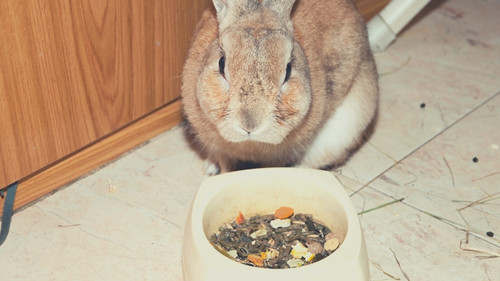
Rabbits are very sensitive to stress and change. Don’t adjust anything with your new bunny’s diet for the first couple of days she’s home with you. Then gradually transition her to your diet of choice over a period of 2-4 weeks.
Foods to Avoid for Rabbits
Rabbits have a sweet tooth and will happily gobble up fruit, oatmeal, cereal, and crackers. But sugary and starchy food – especially if a rabbit isn’t used to it – can shock the gut and cause acute health issues.
Do not feed your rabbit chocolate, granola, or other snacks. You can offer small bits of apple, carrot, or banana as treats once or twice a week. A 1” square cube is plenty.
Don’t Overlook Water
Access to clean water at all times is essential for your rabbit’s health. Water will stay fresh longer if you provide it in a water bottle instead of a dish.
How to Keep Your Bunny Healthy
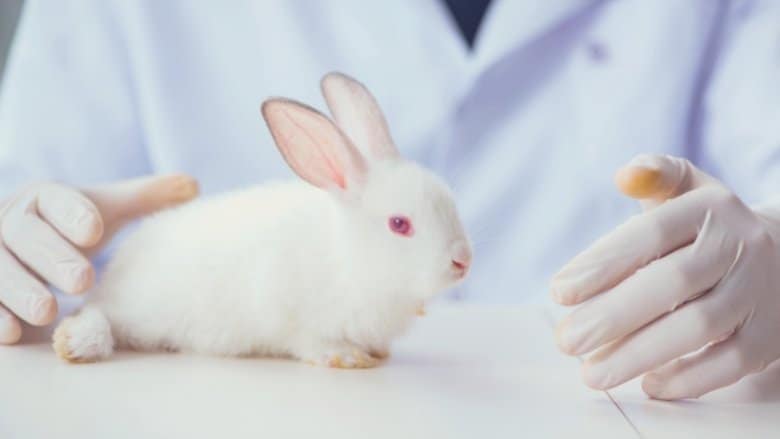
Rabbits are surprisingly tough and generally healthy pets. They need fewer vaccinations and vet visits than most domestic animals.
However, when illness strikes a bunny, it can quickly become life-threatening. Be proactive about protecting your rabbit’s health by taking these steps:
1. Establish a relationship with a vet before there’s a problem.
A good rabbit veterinarian is hard to find, unfortunately. I’ve been surprised to discover how many vets won’t take rabbits at all. If they do, many well-meaning vets don’t see enough of them to be experts in rabbit health.
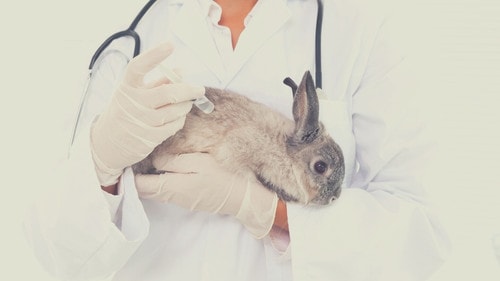
Make calls to several vets and find one you trust before there’s an emergency.
2. Know what a healthy rabbit looks like.
Observe and examine your rabbit every day. As a survival technique, rabbits will try to hide their symptoms if they aren’t feeling well. Make note of your rabbit’s regular habits, so you’ll notice if there’s something “off” about their routine.
Handle your bunny daily. Check their ears, eyes, and nose for discharge or bare spots. Take note of missing or matted fur on the inside of the front legs.
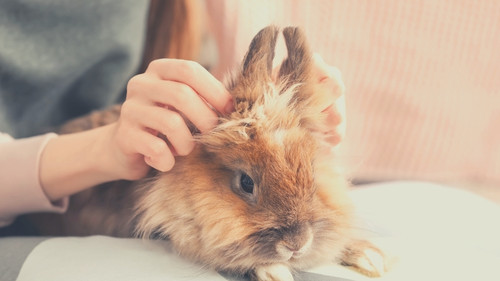
As you pet your rabbit, notice how the fur feels glossy and the vertebrae feel like smooth, round bumps. Loss of fur or flesh condition is a sign of parasites or other health concerns.
3. Keep your rabbit’s environment clean.
Cleaning your furry friend’s cage often is one of the most effective ways to support your rabbit’s wellness. Bacteria and parasites thrive in dirty conditions.
Rabbits living in a cage that hasn’t been cleaned are more likely to develop sore hocks or respiratory problems.
4. Be able to recognize common health problems.
Read about common rabbit diseases so you can identify them when you see them. Have a date night with the Merck Vet Manual or another top pet health resource before bringing your bunny home.
Some of the most common rabbit health problems include:
- Pasteurellosis (snuffles)
- GI stasis
- Sore hocks
- Ear canker (ear mites)
- Bladder sludge or kidney stones
- Obesity
- Teeth issues (malocclusion)
- Weepy eye
- Vent disease
Related: 4 Signs You Have a Sick Rabbit, and What to Do About It
Rabbit Grooming and Hygiene
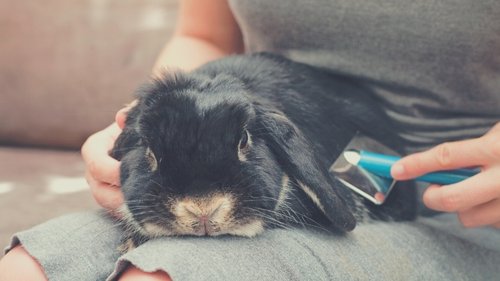
Rabbits love to be tidy. They get flustered if they get a paw wet or dirty, and watching them go through their grooming rituals is so much fun.
A bunny about to groom himself will sit up alert, flick both front feet in a rapid motion, and begin licking his paws, drawing them up and over his face. Like a cat, he’ll lick every inch of his fur from back to belly to tail. He’ll even pull his ears down over his face and clean them, too.
Rabbits groom themselves this way multiple times a day. This process removes dust and loose hairs from their coats and smooths the protecting guard hairs into place.
Do rabbits need baths?
Rabbits don’t need baths. Since they are so careful when grooming themselves, they don’t need humans to give them baths with soap and water.
In fact, bathing rabbits can be harmful, and not only because they would find the experience terrifying.
Bathing a rabbit (especially with soap or detergent) will strip the coat of its natural protective oils and damage the structure of the fur.
What do you do if your rabbit gets dirty?
Hopefully, we aren’t talking very dirty. It’s unlikely that a house rabbit would get filthy enough to warrant a full bath.
If you need to spot-clean your rabbit, use minimal warm water, and try to avoid using soap or detergent.
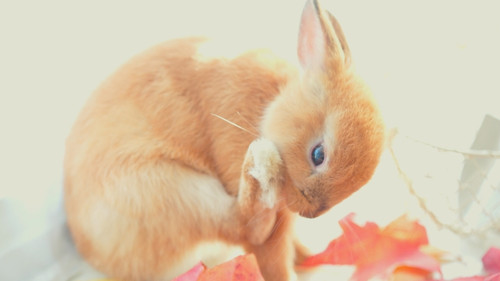
Water mixed with hydrogen peroxide is effective at removing urine stains in fur. Apply hydrogen peroxide with a toothbrush, then a dusting of cornstarch to absorb the stain, and brush it out after a few minutes.
After using water to clean your rabbit, keep her away from drafts. Let her relax in a warm house until she is 100% dry and has had time to groom herself, setting her fur to rights again.
Should you brush your pet rabbit?
Most breeds of rabbits don’t need frequent grooming, though they can benefit from gentle brushing to remove loose hair. A soft silicone brush works great for this.
Breeds with longer hair, called wool, definitely do need regular grooming to keep their coats from matting. Angoras, Jersey Woolies, and American Fuzzy lops are wool breeds.
Grooming the 4-inch-long wool of angora rabbits is an art. It’s best to learn this skill hands-on from an experienced rabbit keeper.
Trimming Rabbit Nails
Not all breeds of rabbits need to be brushed, but all bunnies need their toenails trimmed!
Keep an eye on your rabbit’s claws and clip them as needed (about every 6-8 weeks). You can buy small trimmers made for dogs and cats and use them on rabbit nails.
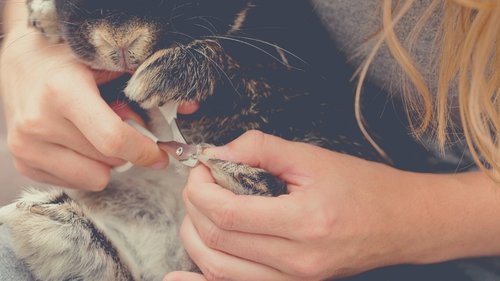
Avoid using trimmers made for humans; they pinch instead of slice and can break the nail.
Examine your bunny’s nails under the light before trimming them so you can see the blood vessel in the nail. Cut the nail a couple of millimeters below the blood vessel.
Meeting a Rabbit’s Emotional Needs
Rabbits love to stay busy and seem to think they’re always doing something important. This makes them a delight to watch as they hop, sniff, lick, and nibble through their daily routines.
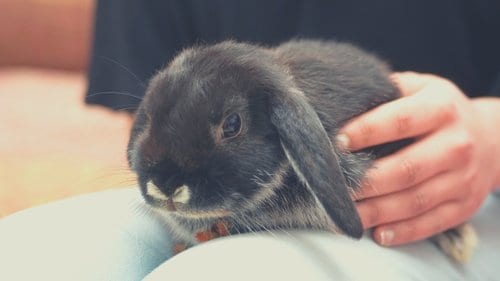
While rabbits spend most of their daytime hours resting, they prefer to be active in the mornings and evenings. Playtime for a happy rabbit includes running, jumping, digging, and chewing activities.
Good Toys for Inside the Cage
Some rabbits will play with balls or bells, but most prefer toys that involve chewing or shredding.
Did you know that rabbit incisors never stop growing? Since a bunny’s signature front teeth grow around 1 centimeter per month, they need to be constantly gnawing on something to keep the teeth at the proper length.
This is why providing free-choice hay is essential for a rabbit’s well-being. Granted, your bunny will make a mess in your home allowed to chew, play in, and make nests with hay, but hay is truly a rabbit’s favorite toy.
You can also give your rabbit a safe hardwood branch to gnaw (such as applewood), or an unprinted cardboard box to shred.
Safe Activities for Outside the Cage
Rabbits should have access to a large run or open floor beyond the cage where they can exercise for 3-4 hours a day. Simply open the cage door and allow the bunny to explore, supervised, at his own pace.
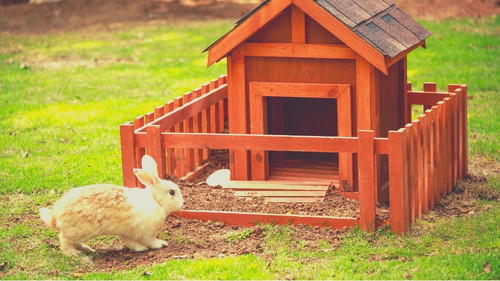
Your new rabbit may take hours or even days to warm up to his new environment. But once comfortable, the silly critter will reward you with a show of dashes, daring leaps, and hilarious binky jumps.
Do rabbits need friends?
Should you get just one pet rabbit, or will he need a companion? This is one of the most common questions new pet parents ask about how to take care of a bunny.
It’s not a simple question to answer. Imagine the rabbits you have seen in the wild. Usually, you’ll see just one at a time out grazing, not a group of them.
Rabbits, unlike guinea pigs or gerbils, are not naturally colony animals. They are territorial and often prefer their own space.
However, there are times when they do seek a companion for grooming or play. As in most areas, rabbits like to have a choice.
My opinion is that rabbits who live alone are more likely to bond with their human companions since they aren’t concerned about competing with the herd.
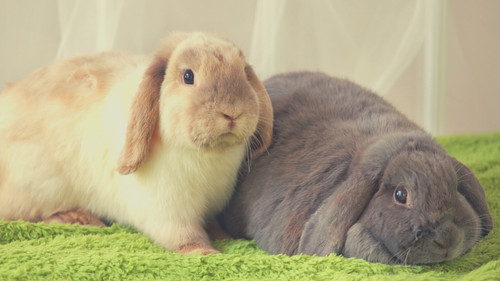
However, if you don’t have ample time to groom and play with your bunny each day, you may want to get a pair of neutered or spayed rabbits so they can meet each other’s emotional needs.
Handling your pet rabbit
Rabbits look so soft and cuddly that your impulse will be to grab and cuddle them! But if you try, you’ll discover that they have very sharp nails!
It takes practice to develop the skill of handling rabbits correctly. But it’s an endeavor worth your time. You need to be able to handle your rabbit often to groom it, check for health issues, and yes, eventually, get that bunny snuggle time in that you’ve been craving.
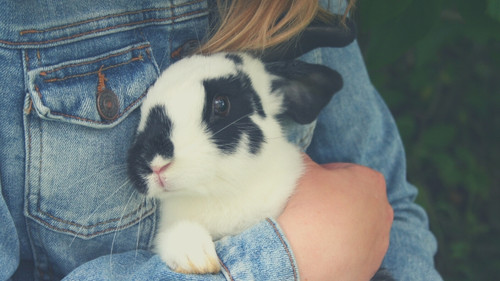
Begin by allowing your rabbit to sniff your hand and slowly get accustomed to your smell. Keep your hand low in the cage. A bunny is more likely to be scared if your hand descends on him like a hawk from above.
As you build trust, start to gently pet her head and ears, watching your rabbit’s body language and giving her space when she needs it.
Conclusion
Rabbit’s care needs are relatively simple. With a healthy diet, a clean environment, enough exercise, and an attentive caretaker, pet bunnies can reward you with a lovely friendship that lasts 8-10 years or more.
I encourage you to continue your research and learn as much as possible about caring for these beautiful, gentle creatures.
Explore the various articles on our website about rabbit care, all written by longtime rabbit owners and experts.
Here’s to your bunny’s health and hoppiness!


